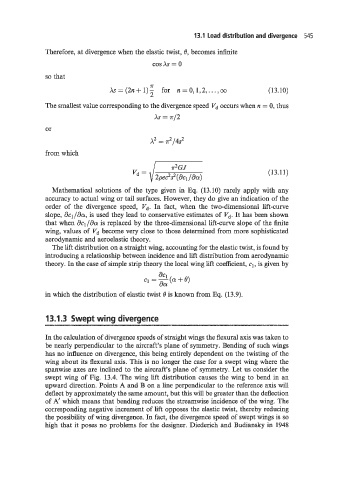Page 564 - Aircraft Stuctures for Engineering Student
P. 564
13.1 load distribution and divergence 545
Therefore, at divergence when the elastic twist, 6, becomes infinite
cos As = 0
so that
7r
h=(2n+1)- for n=0,1,2, ...:oo (13.10)
2
The smallest value corresponding to the divergence speed vd occurs when n = 0, thus
As = 7r/2
or
A2 = 3/4s2
from which
(13.11)
Mathematical solutions of the type given in Eq. (13.10) rarely apply with any
accuracy to actual wing or tail surfaces. However, they do give an indication of the
order of the divergence speed, vd. In fact, when the two-dimensional lift-curve
slope, dcl/aa, is used they lead to conservative estimates of vd. It has been shown
that when acl/aa is replaced by the three-dimensional lift-curve slope of the finite
wing, values of Vd become very close to those determined from more sophisticated
aerodynamic and aeroelastic theory.
The lift distribution on a straight wing, accounting for the elastic twist, is found by
introducing a relationship between incidence and lift distribution from aerodynamic
theory. In the case of simple strip theory the local wing lift coefficient, c1 , is given by
in which the distribution of elastic twist 6 is known from Eq. (13.9).
----- P -1 ____.-
13.1.3 Swept wing divergence
In the calculation of divergence speeds of straight wings the flexural axis was taken to
be nearly perpendicular to the aircraft’s plane of symmetry. Bending of such wings
has no influence on divergence, this being entirely dependent on the twisting of the
wing about its flexural axis. This is no longer the case for a swept wing where the
spanwise axes are inclined to the aircraft’s plane of symmetry. Let us consider the
swept wing of Fig. 13.4. The wing lift distribution causes the wing to bend in an
upward direction. Points A and B on a line perpendicular to the reference axis will
deflect by approximately the same amount, but this will be greater than the deflection
of A’ which means that bending reduces the streamwise incidence of the wing. The
corresponding negative increment of lift opposes the elastic twist, thereby reducing
the possibility of wing divergence. In fact, the divergence speed of swept wings is so
high that it poses no problems for the designer. Diederich and Budiansky in 1948

